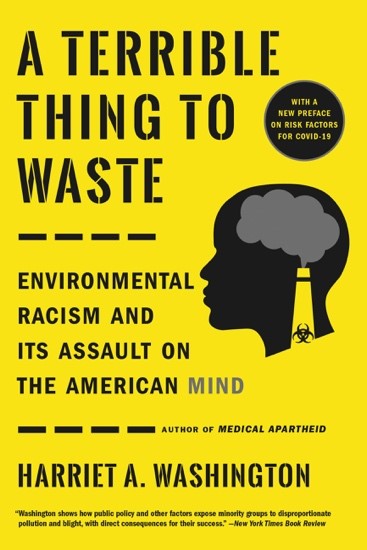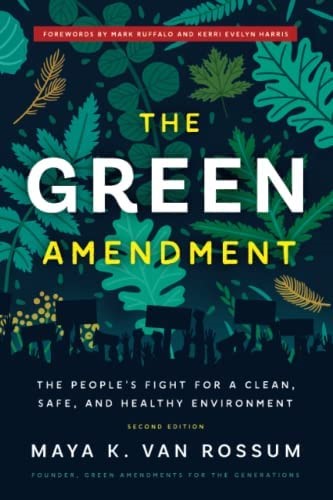EJ Books
The Environmental Justice Movement – with its origins in grassroots activism – was born out of the Civil Rights Movement of the 1960s. That interconnected relationship between both movements has been a catalyst for many authors to write inspirational books about community struggles, successes and lessons learned. Below is a non-exhaustive list of books about environmental justice and the EJ Movement.

“A TERRIBLE THING TO WASTE: ENVIRONMENTAL RACISM AND ITS ASSAULT ON THE AMERICAN MIND” BY HARRIET A. WASHINGTON
From injuries caused by lead poisoning to the devastating effects of atmospheric pollution, infectious disease, and industrial waste, Americans of color are harmed by environmental hazards in staggeringly disproportionate numbers. This systemic onslaught causes irreparable physical harm to millions of people. But these deadly environments create another insidious and often overlooked consequence: robbing communities of color of intellectual power. Science writer Harriet A. Washington investigates heavy metals, neurotoxins, bad nutrition, and even pathogens as agents influencing intelligence to explain why communities of color are disproportionately affected. A Terrible Thing to Waste is sure to outrage, transform, and inspire debate.

“WASTE: ONE WOMAN’S FIGHT AGAINST AMERICA’S DIRTY SECRET” BY CATHERINE COLEMAN FLOWERS

“KATRINA: A HISTORY, 1915-2015” BY ANDY HOROWITZ

"THIS LAND IS OUR LAND: THE STRUGGLE FOR A NEW COMMONWEALTH" BY JEDEDIAH PURDY

"TOXIC COMMUNITIES: ENVIRONMENTAL RACISM, INDUSTRIAL POLLUTION, AND RESIDENTIAL MOBILITY" BY DORCETTA TAYLOR
Taking stock of the recent environmental justice scholarship, Toxic Communities examines the connections among residential segregation, zoning, and exposure to environmental hazards. Renowned environmental sociologist Dorceta Taylor focuses on the locations of hazardous facilities in low-income and minority communities and shows how they have been dumped on, contaminated and exposed. Drawing on an array of historical and contemporary case studies from across the country, Taylor explores controversies over racially-motivated decisions in zoning laws, eminent domain, government regulation (or lack thereof), and urban renewal. Taylor introduces new concepts and theories for understanding environmental racism that will be essential for environmental justice scholars. A fascinating landmark study, Toxic Communities greatly contributes to the study of race, the environment, and space in the contemporary United States.

"UNEQUAL PROTECTION: ENVIRONMENTAL JUSTICE AND COMMUNITIES OF COLOR" BY ERIC K. YAMAMOTO

"FROM THE GROUND UP: ENVIRONMENTAL RACISM AND THE RISE OF THE ENVIRONMENTAL JUSTICE MOVEMENT" BY LUKE W. COLE AND SHEILA R. FOSTER
From the Ground Up critically examines the history of the environmental justice movement. Tracing the movement’s roots, Luke Cole and Sheila Foster combine long-time activism with powerful storytelling to provide gripping case studies of communities across the US–towns like Kettleman City, California; Chester, Pennsylvania; and Dilkon, Arizona–and their struggles against corporate polluters. The authors use social, economic and legal analysis to reveal the historical and contemporary causes for environmental racism. Environmental justice struggles, they demonstrate, transform individuals, communities, institutions and the nation as a whole. An excellent resource for those interested in the history of the movement.

"ENVIRONMENTAL JUSTICE IN A MOMENT OF DANGER" BY JULIE SZE
Environmental Justice in a Moment of Danger examines mobilizations and movements, from protests at Standing Rock to activism in Puerto Rico in the wake of Hurricane Maria. Environmental justice movements fight, survive, love, and create in the face of violence that challenges the conditions of life itself. Exploring dispossession, deregulation, privatization, and inequality, this book is the essential primer on environmental justice, packed with cautiously hopeful stories for the future.

"THE GREEN AMENDMENT: THE PEOPLE’S FIGHT FOR A CLEAN, SAFE, AND HEALTHY ENVIRONMENT" BY MAYA K. VAN ROSSUM

"ZEN AND THE ART OF SAVING THE PLANET" BY THICH NHAT HANH
We face a potent intersection of crises: ecological destruction, rising inequality, racial injustice, and the lasting impacts of a devastating pandemic. The situation is beyond urgent. To face these challenges, we need to find ways to strengthen our clarity, compassion, and courage to act. Beloved Zen Master Thich Nhat Hanh is blazingly clear: there’s one thing we all have the power to change, which can make all the difference, and that is our mind. Our way of looking, seeing, and thinking determines every choice we make, the everyday actions we take or avoid, how we relate to those we love or oppose, and how we react in a crisis. This book is a must read for environmental justice advocates seeking a deeper connection to the Earth and their bothers and sisters.

"FROM THE INSIDE OUT: THE FIGHT FOR ENVIRONMENTAL JUSTICE WITHIN GOVERNMENT AGENCIES" BY JILL LINDSEY HARRISON
“From the Inside Out: The Fight for Environmental Justice within Government Agencies” is a detailed and informative exploration of the challenges faced by government employees working to promote environmental justice within their agencies. Jill Lindsey Harrison is an experienced environmental policy analyst who draws on her own experiences and research to provide a unique perspective on the inner workings of government agencies and the political dynamics that shape their approach to environmental justice. The book is well-written and accessible, making it a valuable resource for anyone interested in understanding the intricacies of environmental policy and the role of government in promoting social and environmental justice. Overall, this is a must-read for anyone working in environmental policy, or anyone interested in understanding the complexities of environmental justice in government.

"DIAMOND: A STRUGGLE FOR ENVIRONMENTAL JUSTICE IN LOUISIANA'S CHEMICAL CORRIDOR" BY STEVE LERNER
Diamond: A Struggle for Environmental Justice in Louisiana’s Chemical Corridor is a powerful and eye-opening account of the fight for environmental justice in Louisiana’s Chemical Corridor. The book is a compelling account of the struggles of the communities living in this area and how they are affected by the pollution caused by the chemical industry. Steve Lerner does an excellent job of weaving together personal stories, historical research, and critical analysis to provide a comprehensive understanding of the environmental justice issues at play. The book is well-written, engaging, and provides valuable insights into the ways in which marginalized communities are disproportionately affected by environmental degradation. Overall, this is a must-read for anyone interested in environmental justice, community activism, and the impact of the chemical industry on local communities.

"MAKING LIVABLE WORLDS: AFRO-PUERTO RICAN WOMEN BUILDING ENVIRONMENTAL JUSTICE" BY HILDA LLORÉNS
Making Livable Worlds: Afro-Puerto Rican Women Building Environmental Justice is a thought-provoking and informative book that explores the intersection of race, gender, and environmental justice through the lens of Afro-Puerto Rican women. Hilda Lloréns skillfully weaves together personal narratives, historical research, and critical analysis to paint a comprehensive picture of the challenges faced by these women in their fight for environmental rights and sustainability. The book is well-written, engaging, and offers valuable insights into the ways in which marginalized communities are disproportionately affected by environmental degradation. Overall, this is a must-read for anyone interested in environmental justice, race, and gender studies.

"THE INTERSECTIONAL ENVIRONMENTALIST: HOW TO DISMANTLE SYSTEMS OF OPPRESSION TO PROTECT PEOPLE + PLANET" BY LEAH THOMAS
The Intersectional Environmentalist is an important and timely book that explores the intersection of environmental justice and social justice. Author Leah Thomas examines the inextricable link between environmentalism, racism, and privilege, and promotes awareness of the fundamental truth that we cannot save the planet without uplifting the voices of its people — especially those most often unheard. This book is simultaneously a call to action, a guide to instigating change for all, and a pledge to work towards the empowerment of all people and the betterment of the planet. Thomas shows how not only are Black, Indigenous and people of color unequally and unfairly impacted by environmental injustices, but she argues that the fight for the planet lies in tandem to the fight for civil rights; and in fact, that one cannot exist without the other.

"CLIMATE CHANGE FROM THE STREETS: HOW CONFLICT AND COLLABORATION STRENGTHEN THE ENVIRONMENTAL JUSTICE MOVEMENT" BY MICHAEL MENDEZ
Environmental planner Michael Méndez tells a timely story of people, place, and power in the context of climate change and inequality. He explores the perspectives and influence low-income people of color bring to their advocacy work on climate change. In California, activist groups have galvanized behind issues such as air pollution, poverty alleviation, and green jobs to advance equitable climate solutions at the local, state, and global levels. Arguing that environmental protection and improving public health are inextricably linked, Mendez contends that we must incorporate local knowledge, culture, and history into policymaking to fully address the global complexities of climate change and the real threats facing our local communities.

"A BIGGER PICTURE: MY FIGHT TO BRING A NEW AFRICAN VOICE TO THE CLIMATE CRISIS" BY VANESSA NAKATE
Vanessa Nakate’s book A Bigger Picture: My Fight to Bring a New African Voice to the Climate Crisis is a long-awaited addition to recent books by young climate activists. Nakate is a Ugandan activist in her early 20s who writes in a compelling voice about her youth climate activism, the national and international barriers she has faced, and the importance of inclusive movements for climate and environmental justice.

"FIGHTING TO BREATH: RACE, TOXICITY, AND THE RISE OF YOUTH ACTIVISM IN BALTIMORE" BY NICOLE FABRICANT
Industrial toxic emissions on the South Baltimore Peninsula are among the highest in the nation. Because of the concentration of factories and other chemical industries in their neighborhoods, residents face elevated rates of lung cancer and other respiratory illnesses in addition to heart attacks, strokes, and cardiovascular disease, all of which can lead to premature death. Fighting to Breathe follows a dynamic and creative group of high school students who decided to fight back against the race- and class-based health disparities and inequality in their city. For more than a decade, student organizers stood up to unequal land use practices and the proposed construction of an incinerator and instead initiated new waste management strategies. As a Baltimore resident and activist-scholar, Nicole Fabricant documents how these young organizers came to envision, design, and create a more just and sustainable Baltimore.
Please Contact Us to add books to this growing EJ Books list!
